Since I haven’t shown you any instruments for a while, I’m going to throw a whole bunch at you now. And there’s much still to come!
 Last blog, I left off at the Sforza Castle museums with a view of the hallway display of the Monzino Collection.
Last blog, I left off at the Sforza Castle museums with a view of the hallway display of the Monzino Collection.
This is where I spent the bulk of my time, as I have long been fascinated by the images on the site of the Fondazione Antonio Carlo Monzino, which have been included on Harpguitars.net for some time. The images, however, are small, low-resolution photos, so I was excited to see the real thing. Unfortunately, only about half of the collection was on display, but what I saw, I was in love with. Many of these are amazingly fine instruments, in seemingly mint condition.
Starting from the far end of the hall, where one enters, I immediately spotted a familiar shape among the old guitar molds from the Monzino shop: a harp mandolin, looking a bit like my own. It looked about 3-1/2” deep.
A couple of fine early guitars and mandolinos. BTW, all the provenance of these instruments should be available on the Monzino site here.

This is an interesting one. Built by Giovanni Gelmini in Brescia in 1844. It has a simple, small body, about the size and shape of an early Gibson L-series guitar, with a soundhole about 2” in diameter. PS: Please ignore the idiot photographer’s reflection in these images.
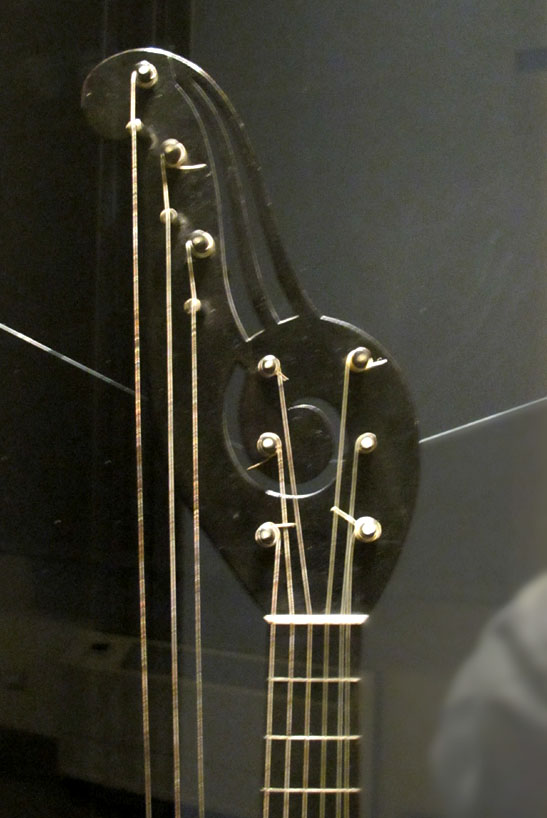
The headstock, by contrast, is quite an elaborate affair – though perhaps simple in construction – and completely distinctive amidst the thousands of harp guitars in the Harpguitars.net Galleries.
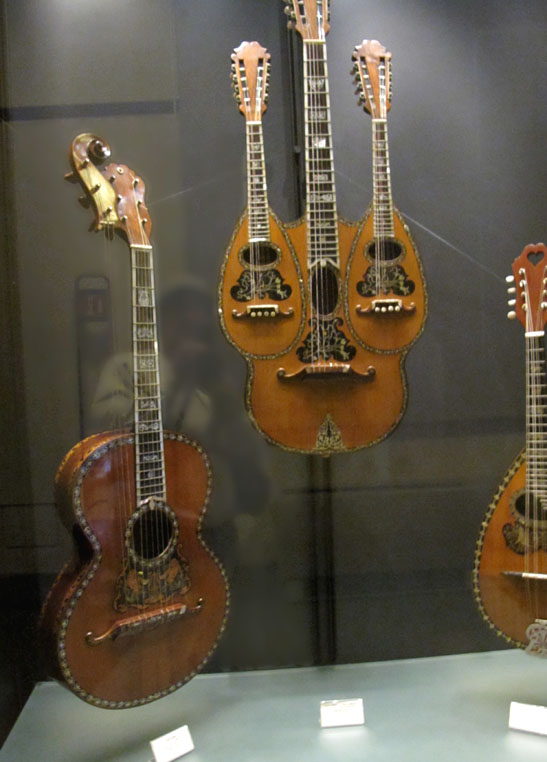
A beautiful theorbo-style harp guitar by Innocente Rottola of the Cremonese school, built in 1906. And the same maker’s stunning triple-neck – a guitar with stereo mandolins!

The intricate side inlay of the Rottola.
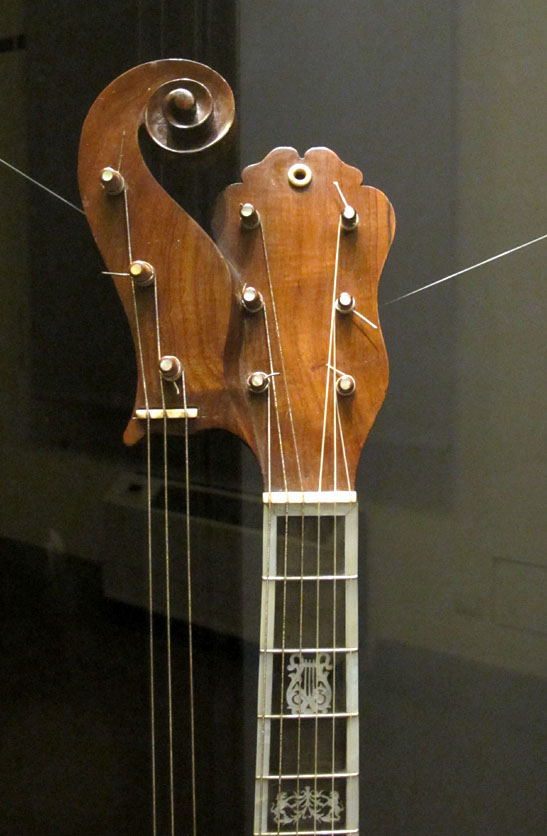
Exquisite fingerboard inlays and beautifully carved compound headstock

A beautiful hollow-arm harp guitar built by Severino Riva in Milan in 1911. I would imagine gut strings would be more proper? The Collection also has a similar instrument by Luigi Galimberti from 1910, with 8 basses, not on display.

Elaborate and beautiful carving and inlay.



A large reproduced image showing Milan’s mandolin and guitar orchestra in 1886. Note the 3 harp guitars and the Milanese lyre guitar that looks much like the specimen on exhibit:

A c.1920 Lyre guitar by the Monzino & Sons and lyre-mandolin (mandolira) by A. Monzino and Garlandini. 2 exquisite mandolins and a Cetra di Nerone (“Nero’s Lyre”) by Parravicini Piero built in 1924 for an opera. It has no fingerboard (ergo, not a “lyre guitar” at all), though it does have 6 strings, tunable from pins in the back.

Note the singer with the instrument in the production. Though a “prop,” it is a beautifully made one. It has a deep, hollow body with a fine spruce top – so, despite the theatrical accouterments, it may have sounded great plucked or strummed in an open chord.
I’ve seen several pictures of these, but never one “in the wood.” A 4-string bowed guitar (arcichitarre). This one is roughly cello-size, made by Riva also.
The reproduced Method shows a performer with one (plucking), and with the larger bass version, dubbed the chitarrone. Incredible!
As I said, I still wished I could’ve seen a couple of other instruments, like the Giulietti harp guitar (featured in our Special Feature on Harpguitars.net) and especially this one:

What was it? As luck would have it, later in the week, my friend Alberto Giordano would give me his copy of the Sforza Musical Instrument CD-rom. A nice, if slow-to-browse, multimedia reference source, it allowed me to zoom in on the instruments. Thus, I was now able to see that the unlabeled c.1900’s Sorta di Cetera con Bordoni (a “sort of cittern with drones”) had 8 strings on the neck, 3 of which (#5,6,7?) could be sharpened with long “finger capos” presumably activated from behind.

The curious fretted extension for the 8 sub-basses obviously functions as a “capo platform,” with a simple but clever device able to slide along the center slot, to clamp against any of the 5 or 7 frets for transposing all strings for different keys. Note that the neck has a fan-fret biased scale (!) while the bass is straight to allow the capo device to work. I wonder where this came from, and how it ended up in the Monzino collection. Were the neck strings tuned open, with this yet another take on the old C-E-G-tuned cittern-like English Guitar? Such instruments tend to have sharping and capoing devices for simple key changes for the simple playing techniques. Or is it meant to be more of an elaborate harp guitar, with 10 extra strings? Gut or steel strings? A curious hybrid, indeed.
I kept going back to the Monzino hall, as I liked the presentation and it had such great pieces. But the rest of the collection had some cool things as well, spread out in the large castle halls.


I was disappointed that the many nice keyboards and harps were in a huge room that was also hung with rare tapestries. Because of them, the light was kept to a minimum. Ergo, I didn’t photograph much (I couldn’t really see much). I had to do later major Photoshopping to see their best harp, here.

This one was in better light. An unlabelled Viennese instrument, c.1815-1820. I continue to crave adding a giraffe piano (in harp form, naturally) to our own home. You’ll all have to work on Jaci for that one to happen.
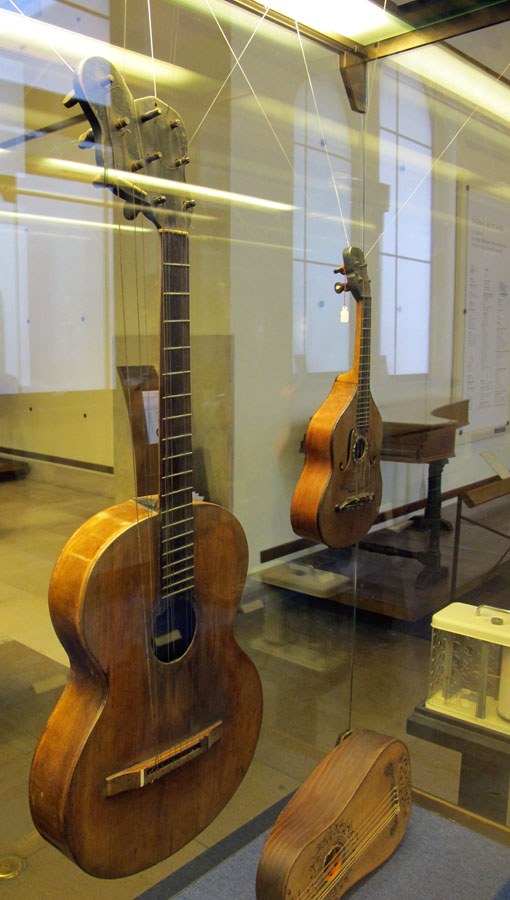
A pretty rough 1836 Guadagnini harp guitar in the typical 3-bass Viennese style with a replaced bridge. I’m not sure I’d be displaying this one.
There were two huge and wonderful 1760-1780 bass mandolones by Gaspari Ferrari of Rome, each with 2 floating bass courses, as was often done. In other words, a large bass mandola, with 6 fretted courses and 2 floating (all in pairs), and apparently meant to be metal strung?


This very lovely and distinctive Italian lyre guitar (19th century, unlabelled) might be the very specimen I include in my Lyre Guitar Gallery. Like meeting an old friend!
While this one, of unknown provenance (Spanish, I believe?), is a delightful, folksier version with a fish bridge and moon face inlay.
Another instrument I’d never seen in person: a wonderful arch-cittern of the older “true” configuration, resembling the 1755 Klemm in my Arch-Citterns Gallery.

This last instrument fascinated me…what in the world is going on? A large viol strung like a harp? I want one! In fact, it’s like a “harp-viol,” with fretted strings and floating subs – cool! But wait a minute…that severely slanted bridge would mean – yes, it’s an “impossible instrument.” The perpendicular frets couldn’t be used! So what then? It’s not terribly “high end,” but it was built by an instrument maker, with simple but decent quality. Were the frets ignored, with it just plucked or strummed like a harp? Was it played at all? Amazingly, that very night, I would see an exact duplicate of this unusual antique instrument (at our next stop and next blog). We agreed that they were most likely made – like the “stage lyre” above – as “functional fantasy props” for one of the local opera productions.
Next: A visit with theorbo player Giorgio Ferraris!
You can also go back and begin at the start of our 2012 Italian adventure here: Another Genoese Feast, with a Side Dish of Milan

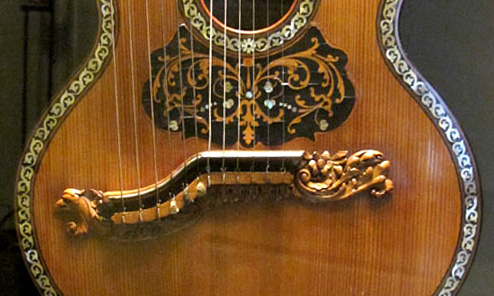






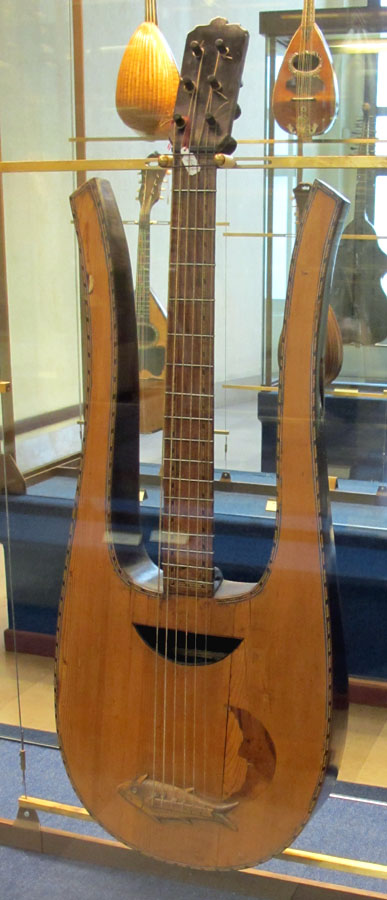

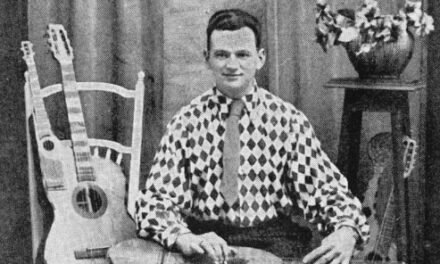



Cool, Gregg!
I love the Riva harp guitar. I could play that one. It’s got the right number of sub-basses and they look like they’re spaced nicely. Wonder what it sounds like…
Guess that can’t be known any longer though.
Great pics!